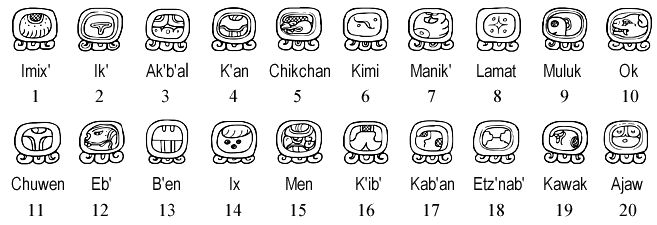TZOLKIN CALENDAR - MAYAN SACRED CALENDAR

TZOLK'IN CALENDAR: SACRED 260 DAY (KIN) MAYAN CALENDAR CYCLE
The Tzolkin calendar (also spelled "Tzolk'in" in modern Yucatec Maya) is a sacred cyclical count consisting of 260 days within the ancient Mayan calendar system. It is generally considered by most Mayanists and Mesoamerican researchers to be the regions oldest calendar count.
The original ancient Mayan name for this "divine" 260 day period is currently not known. While the word Tzolkin, meaning "Division of Days", is a western invention coined in Yucatec Maya, the K'iche' Maya still refer to it as the "Ch'olk'ij" or "Count of Days". The corresponding words used by the K'iche' and Kaqchikel peoples of Guatemala have been spoken unbroken for over 500 years. They are respectively: the Aj Ilabal Q’ij or 'Sense of the Day', and Chol Q'ij, 'Organization of Time'. The Tzolkin is also referred to as the Maya Sacred Round and considered by many to be the most important period count of the many within the Mayan calendar system.
Speculations about reasoning for the development of a 260 day cycle count suggest that it may have been created to help keep track of the human gestation period, the agricultural cycle of maize, or the interval period between two zenithal passages of the sun. The later theory is currently assumed by many to have the most suport. Again, however, the exact mindset of our Mesoamerican ancestors at the time of its development isn't known for sure. What is universally agreed upon with absolute certainty is that there are some extremely important 'mathematical relations' utilizing the numbers 13 and 20 which were considered to be of great significance for all Mesoamerican cultures and specifically useful to the Maya for their purposes of divination. When these two numbers are multiplied the result is equal to 260. Thus, this 13 x 20 matrix is the essential core foundation of the Tzolkin and basis for its functionality within Mayan society.
In the Tzolkin, there are twenty named days in thirteen named periods of time. Similar to our modern calendar system having 7 named days, Sunday through Saturday, in a period of time known as a week; the Tzolkin calendar consists of 20 named kin (days), Imix through Ajaw (also spelled 'Ahau'), in a thirteen day period of time known as a "trecena". Unlike our modern calendar system, however, so important were the named days to the ancient Mesoamericans that each was associated with its own particular diety and given a glyph within their respective language. Below are the 20 days used in the Tzolkin along with their associated diety and glyph (also called "Day Sign" for this specific type of usage) in modern Yucatec Maya.

Every day in the sacred Tzolkin calendar cycle (260 kins) had a named position for the fusion combining one of the numbers from 1 to 13 with one of the 20 sacred day signs. The 260-day count began with 1 Imix', followed by 2 Ik', 3 Ak'b'al, and 4 K'an, etc., until 13 B'en had been reached. Now, because the naming sequence only allowed for use of the first 13 numbers, the next named position in the 260 day cycle after 13 B'en would be called 1 Ix, followed by 2 Men, 3 K'ib', and 4 Kab'an, etc. The last day of the 260-day cycle would fall on 13 Ajaw. Once it was reached, the cycle would then begin to repeat commencing with 1 Imix' all over again. Thus, one full cycle of the sacred Tzolkin cycle is completed when all thirteen numbers have been combined with all 20 sacred day signs (13 x 20 = 260). Because each of the twenty sacred day signs is associated with its own divinity, every particular day is considered to have the personality or characteristics of their specifically named diety. The Tzolkin was therefore used as a means of divination and guide for the performace of rituals used in sacred ceremonies. Unlike other componenets in the Mayan calendar system which were based on movements of the stars and planets, the Tzolkin's 260-day cycle was derived solely from mathematics and not based on any natural phenomenon at all. It is the only known example of an ancient and/or contemporary culture daily fusing purely mathematical operations alone, along with the spiritual, for the performance of a society's most sacred rituals, celebrations, and prophecies.
Usage of the Tzolkin cycle can still be seen amongst the Quiche Maya priests and daykeepers of the Guatemalan highlands, and inhabitants in the Mexican state of Oaxaca today. While its use is marginal, it is again spreading; with continued opposition from some Christian churches. ( article by: Angel Tenez, 2009 )

